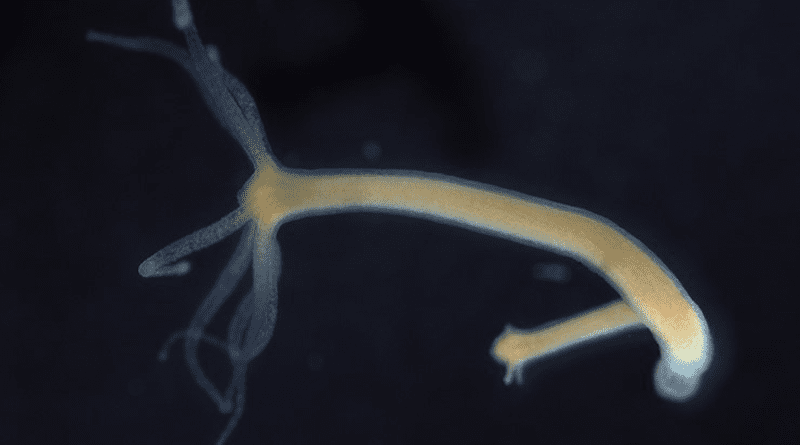Mechanical Forces Shape The ‘Immortal’ Hydra
Hydras are named after a mythical serpent monster that regrows two heads each time one is cut off. The myth isn’t too far from the freshwater invertebrate’s regenerative abilities: these minuscule organisms are just a hollow tube with two-cell thick walls, a tentacle-rimmed mouth and a sticky foot, but they are able to renew their stem cells, which can develop into all the different types of specialized cells that make a body.
Chop a small piece of Hydra tissue that contains some stem cells, and they will start dividing and differentiating to rebuild the rest of the animal. As this process takes place, the regenerating body blows up — much like an inflating balloon, says study senior author and FMI group leader Charisios Tsiairis. The only difference is that the Hydra body fills up with water rather than air. At some point, the water pressure is so high that it results in tears in the Hydra’s body walls. The tears allow water to escape, causing the entire animal to shrink.
Scientists have known that Hydras hinge on cycles of inflation and deflation to regrow their bodies. To test whether and how mechanical forces generated by periodical blowing up and shrinking are linked to regeneration, Jaroslav Ferenc, a PhD student in the Tsiairis group, and his colleagues analyzed scraps of Hydra tissues as they grew into an adult animal.
The researchers found that, during regeneration, the increasing water pressure inside regenerating Hydras causes cells to stretch. This stretching turns on genes that are important for the formation of the animal’s head structures, such as the mouth.
The study also revealed that the expression of one particular gene, called Wnt3, rises as tissue stretching increases. “It seems that one main outcome of this stretching is the activation of Wnt3 expression,” Tsiairis says. Wnt3 is part of a large family of genes that play key roles in development by providing instructions for making proteins that relay chemical signals in the body.
Further experiments showed that if cells don’t stretch, Hydras tend to regenerate only the animal’s foot structures. “These animals cannot develop further, because they don’t have a head or a mouth — they can’t feed,” Tsiairis says. However, when the researchers engineered Hydras to overexpress Wnt3, the animals could regenerate the head structures, even without tissue stretching. The results were published in the journal Science Advances.
Pressure to develop
In the past decade, mechanical forces have been implicated in a score of biological processes — from embryonic development to organ formation to abnormal cell growth in cancer. Understanding how these forces guide stem cells toward their fates could help to reveal how a fertilized egg gives rise to an adult organism, but also how certain diseases arise.
What’s more, inflation-deflation phenomena like the ones observed in Hydras appear to be important for the differentiation of cells in hollow tissues and organs, including the gut and the alveoli — balloon-shaped structures where the lungs and the blood exchange oxygen. “Hydra offers a model to show that there is a unifying property: the patterning of epithelial lumens through mechanical signals is very conserved, and I wouldn’t be surprised if Wnt signaling popped up in more and more of these systems,” Tsiairis says.
Some of Tsiairis’ findings suggest that, as Hydra develops, the default differentiation pathway leads cells to make a foot structure. He speculates that in the absence of Wnt3, all cells follow the default pathway, whereas when Wnt3 is present, it ‘tells’ some cells to take an alternative differentiation avenue, which leads to the formation of the head. The researchers are now testing this hypothesis in the lab.
Other burning questions relate to the molecular pathways that link mechanical forces to gene expression. “Now, we know that mechanical stretching activates Wnt3 expression, but we don’t know how cells translate this mechanical stretching into gene regulatory activities,” Tsiairis says. His team is also investigating whether the level of stretching of cells determines their gene-expression responses. “It’s likely that cells that stretch more are the ones that activate Wnt3,” he says.

